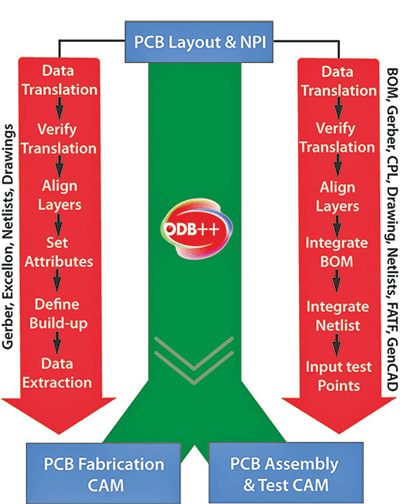Using the ODB++ data format ensures PCB manufacturers have all needed information in a single, automation-compatible file
BY JULIAN COATES
Director of Business Development
Mentor Graphics
www.mentor.com
Once a circuit design is complete and the PCB has been laid out, the complex process of transferring all the design data to manufacturing begins. The data communicate not only the physical positions of components, traces, and layers, but also the intent. On top of this is manufacturing data: where to drill, what to mask, and how to apply the board stencil.
For decades this data exchange has required a lot of different files, each containing a part of the final picture, somewhat like a jigsaw puzzle. These files include Gerber data with the physical layout of the PCB; Excellon drill data; netlists; and many others as needed.
After receiving this set of files, the PCB fabricator or assembler must put the puzzle back together, perform a time-consuming verification process to determine if all the necessary files are there to produce the PCB, and determine if the data are correct. Because the process has a lot of manual input, human errors often creep into the information. Fabricators estimate that about one-quarter of all Gerber file sets received have errors.
Intelligent data format
The better way to transfer data is to have an intelligent data format from the outset. Since ODB++ was first introduced in 1995, it has been implemented by PCB design and manufacturing organizations both large and small, globally. ODB++ format output is available on virtually all major CAD/CAM tools. Although not a formal standard, it has been accepted to the point of being a de facto standard, adopted by many top-tier electronics manufacturers for many years already. It was created and maintained by Valor Computerized Products. When Mentor Graphics acquired Valor, Mentor re-pledged continuing support for maintaining and advancing the ODB++ format. Recently formed, the ODB++ Solutions Alliance (www.odb-sa.com) provides a forum for implementers and supporters of the ODB++ format to share their interest and success with others.
The ODB++ format
The ODB++ format is an open ASCII file structure containing all product data for fabrication, assembly, and test in a single file, including DFM analysis (see Fig. 1 ). Because of design and data quality checks, the ODB++ file does not need the rigorous examination by the fabricator. Minimizing the amount of manual manipulation and packaging required data together ensures high quality and quick turnaround.

Fig. 1: ODB++: One file for fabrication, assembly, and test.
In addition to the usual set of information conveyed in ODB++, many attributes can be communicated as well, and automatically. Attributes such as impedance, plugged vias, surface finish, and others can be included and automatically read and understood by the fabricator. Users can also assign user-defined attributes of characteristics to easily communicate this information both internally and to suppliers that have been chosen to receive the definition of the attribute.
While a great deal of product design information is contained in the ODB++ file sent to the fabricator, there is no risk of disclosing important IP. ODB++ can carry net names, inner layer information, and component data up to the level that the user feels appropriate for transmission into manufacturing, according to how the CAD or DFM tool is configured to create and manage the data. The intention of ODB++ is to give all necessary information to manufacturing in an intelligent and integrated data-structure, enabling the most efficient manufacturing.
Advantages are great
The significant advantages and automation abilities associated with the ODB++ format make it the clear choice for manufacturing data transfer in the future. Fewer errors mean less expense, fewer re-spins, and quicker turnaround on PCB fabrication, assembly, and test. The integrated DFM data helps ensure that board assembly will proceed without any glitches to send the process back to design. The future of PCBs includes ODB++. ■
Advertisement
Learn more about Mentor Graphics





